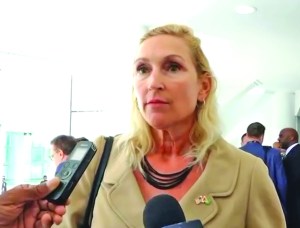The Government of Guyana has provided a comprehensive response to the latest round of queries from the United States Department of Agriculture (USDA), as part of ongoing efforts to lift the longstanding ban on the export of wild-caught catfish to the US. Speaking on the sidelines of an event on Monday, US Ambassador to Guyana, Nicole Theriot, said Guyana had submitted its most recent responses as recently as last month—demonstrating its commitment to resolving the matter.
“It’s a very long process unfortunately. Most recently in the latest step the Government of Guyana has responded quite comprehensively to the latest round of questions that we had,” Theriot noted.

The US has maintained a ban on catfish exports from Guyana since 2017, during the administration of former President David Granger. At the time, Guyana’s catfish exports to the US were valued at approximately $1.8 billion.
Ambassador Theriot emphasised that the delay in resolving the matter is not due to a lack of action on Guyana’s part, but rather the extensive workload facing US authorities, who are simultaneously dealing with similar requests from more than 180 countries.
“It takes some time unfortunately. We’re dealing with 180 other countries,” she said. “But they are aware that this is a priority for us and for the Government of Guyana.”
Since entering office in 2020, the current People’s Progressive Party/Civic (PPP/C) Government has been working assiduously with the USDA to reverse the ban.
“Obviously the whole point of the current band is simply to make sure that everything that comes into the United States is safe for consumers. It’s about safety and phytosanitary. The Department of Agriculture is currently reviewing all of those responses and then once they’ve done that, they will either ask additional questions or they will choose to lift the band,” Theriot said.
According to the US regulations, Guyana must be able to catch catfish and transport it to a processing plant while it is alive. This is in contradiction to what is being practiced here, whereby the fish is caught, disemboweled and the carcass is iced until it reaches the shore.
Exporters of catfish were required to provide documentation to verify that their inspection system was equivalent to US standards. The failure to do this resulted in the US imposing a ban on catfish imports from Guyana and other non-compliant countries.
Guyana is also required to have inspectors at the plants along with documentation of sanitation and the Hazard Analysis and Critical Control Point (HACCP) during the packaging process. It also needs to provide information on how adulterated catfish products are managed.
As Guyana continues to strive to meet these standards, there has been multiple exchanges between authorities from both sides with the US Department of Agriculture’s Food Safety and Inspection Services (FSIS) requesting additional documentation and information from its Guyanese counterpart.
Guyana has been engaging the US Government at high levels on reversing the catfish ban. In fact, the matter was raised with former US Secretary of State, Mike Pompeo, during a visit to Georgetown in September 2020 and he had committed to reviewing the ban on catfish.
Agriculture Minister Zulfikar Mustapha had previously lamented that the local fishing industry has severely been affected by the ban. The wild-caught catfish, especially ‘gilbaka’, has been in great demand within the Guyanese diaspora in the US.
Discover more from Guyana Times
Subscribe to get the latest posts sent to your email.











